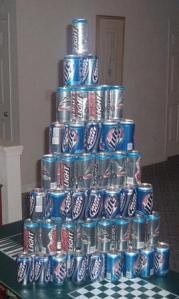Being a discourse on the properties, and methods of construction, of the so called Beer-a-mid.

This structure should have 120 cans.
The “Beer-a-mid”, or Beeramid, or perhaps even Byramid, is a slang term for stacks of beer cans in a pyramid shape. Of course it doesn’t have to be beer cans. Really any kind of beverage-can works. (Or for that matter, any unit or particle). I had the idea of working out some kind of equation to tell how many cans would be in a pyramid of a given height.
First off, there are different types of beeramids. By definition, I suppose the simplest would have to be a zero-dimensional structure, consisting of one can. The equation describing this is: “number of cans = 1 can”. Let me know if that’s too complicated. Then there’s a sort of “linear”, 1-dimensional pyramid, which is simply a line of cans. Things actually become interesting though when the subject is a 2-dimensional pyramid. What’s the equation for that?
Going from top to bottom, the first layer will have one can, the second layer will have two cans. The third layer will have three and so on. Still not all that difficult. The total number of cans in a pyramid is the sum of the number of cans in each row. So a 4 layer pyramid has (1 + 2 + 3 + 4) cans, or 10 cans. I started thinking about it, and found that this is pretty simple to express using Sigma notation:
 H = height.
H = height.
So, 2d Pyramids, done. How about a 3d pyramid? Here there are some choices. In particular, the base of the pyramid may be shaped in different ways. The Giza pyramids have a square base. But there’s also the tetrahedron, a pyramid with a triangle base. Let’s consider that one first.
From top down, the first layer has one can. The second layer has three cans. The third layer has 6 cans. Less straightforward this time. However, each layer on the 3d pyramid is just a 2dpyramid on its side. Further, the “Height” of this 2d pyramid is equal it’s place on the 3d pyramid. So, the 3rd layer of the 3d pyramid is a 2d pyramid of height 3. The 8th layer of a 3d pyramid is a 2d Pyramid of height 8. Since I already have an equation for 2d pyramids, I can add up progressively higher layers using a nested sigma formula:
 The only input variable is height “H”. Note the 2d pyramid equation tucked in there.
The only input variable is height “H”. Note the 2d pyramid equation tucked in there.
I used a regression utility to work the results of this into polynomial form: number of cans =  . I don’t understand how this works, or why it works, but it’s pretty handy for a quick calculation.
. I don’t understand how this works, or why it works, but it’s pretty handy for a quick calculation.
With that down, what about 3d Pyramids with square bases? Turns out that each layer of the pyramid is a square, with an area equal to it’s layer number squared. So, the 2nd layer has 4 cans (22 = 4), and the third layer has 9 cans (32 = 9). The equation for that pyramid can be gotten by making a small change to the triangle base equation. The inner sigma is gotten rid of, and replaced with a squaring operation:

So those are my equations. Kind of cool. The nested loops translate pretty easily into programming languages so I already have a program on the ti-82 that will do all this for me. That’s probably one of the nerdiest things I’ve ever done. Ah well.
And what comes next? I wanted to work out something more general. I’ve found that bases of n-sided shapes don’t always come together in real life. There’s something lurking there, like determining which 2d shapes with integer sides have integer areas. Something like that anyway. And what about can overlap!? The above equations all have a can resting on top of two or more cans in the layer below it. But a can could just as easily be placed directly on top of a single can below it. The cans represent perfect, abstract points, only they’re real things. The variations are crazy. And I can’t help but think of the Platonic Solids. Ahh well. Perhaps I’ll work something more general out, and cover that at a later date.


 Delicious
Delicious


